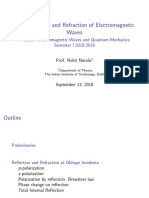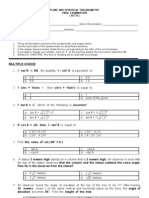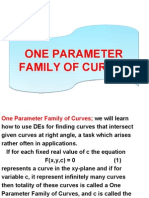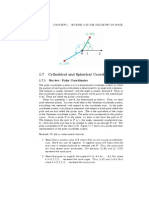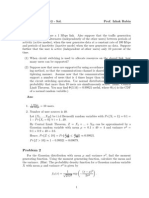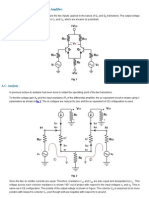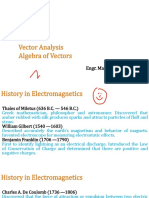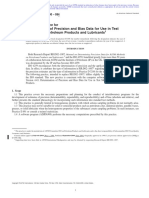Vector Lessons
Uploaded by
Marc RiveraVector Lessons
Uploaded by
Marc RiveraA1 2005
1/1
2A1 Vector Algebra and Calculus
David Murray
david.murray@eng.ox.ac.uk www.robots.ox.ac.uk/dwm/Courses/2VA
Michaelmas 2005
A1 2005
2/1
Vector Calculus & Scalar Fields
Think about some scalar quantities mass M, length L, time t, temperature T , etc If r = [x, y, z] is a position in space, T (r) is a scalar eld T might be time-varying the eld is T (r, t) Keep y, z, t constant. What is T when you move x?
z
T =
T x
x.
But suppose you moved of in a direction n. Would you multiply T T = n ? n
x y
Does T /n exist is it a vector or a scalar?
A1 2005
3/1
Vector Calculus & Vector Fields
A vector quantity v(r) that has a value at every r in a region is a vector eld. Examples are: The electric eld E(r) around stationary charges The unsteady uid velocity eld v(r, t) in a stream.
Local stream velocity v(r, t) can be viewed using: laser Doppler anemometry, or by dropping twigs in, or diving in ... Youll be interested in
weirs (acceleration), & vortices (curls)
A1 2005
4/1
Contents
1 2 3 4
Revision of vector algebra, scalar product, vector product. Triple products, multiple products, applications to geometry. Differentiation of vector functions, applications to mechanics. Scalar and vector elds. Line, surface and volume integrals, curvilinear co-ordinates . Vector operators grad, div and curl. Vector Identities, curvilinear co-ordinate systems. Gauss and Stokes Theorems and extensions. Engineering Applications.
5 6 7 8
A1 2005
5/1
Learning Outcomes
comfort with expressing systems using vector quantities manipulating vectors as atomic entities without recourse to underlying coordinates sound grasp of the concept of a vector eld ability to link this idea to descriptions various physical phenomena intuition of the physical meaning of the various vector calculus operators (div, grad, curl) ability to interpret the formulae describing physical systems in terms of these operators
A1 2005
6/1
Reading
J Heading, "Mathematical Methods in Science and Engineering", 2nd ed., Ch.13, (Arnold). G Stephenson, "Mathematical Methods for Science Students", 2nd ed., Ch.19, (Longman). E Kreyszig, "Advanced Engineering Mathematics", 6th ed., Ch.6, (Wiley). K F Riley, M. P. Hobson and S. J. Bence, "Mathematical Methods for the Physics and Engineering" Chs. 6, 8 and 9 (CUP). A J M Spencer, et. al. "Engineering Mathematics", Vol.1, Ch.6, (Van Nostrand Reinhold). H M Schey, Div, Grad, Curl and all that, Norton
A1 2005
7/1
Course WWW Pages
Pdf copies of
these oheads lecture notes (also large print), tutorial sheets (also large print) FAQs etc
will be accessible from www.robots.ox.ac.uk/dwm/Courses/2VA If something is really not clear, and you are really stuck,
email david.murray@eng.ox.ac.uk
and the reply (if generally useful) will get stuck on the web FAQs.
A1 2005
8/1
Vector Algebra and Calculus
1 2 3 4
Revision of vector algebra, scalar product, vector product Triple products, multiple products, applications to geometry Differentiation of vector functions, applications to mechanics Scalar and vector elds. Line, surface and volume integrals, curvilinear co-ordinates Vector operators grad, div and curl Vector Identities, curvilinear co-ordinate systems Gauss and Stokes Theorems and extensions Engineering Applications
5 6 7 8
A1 2005
9/1
Vector Algebra
In which we explore ... Free, sliding and position vectors Coord frames and Vector components Equality, magnitude, Addition, Subtraction Scalar products, Vector Projection, Inner products Vector Products
A1 2005
10 / 1
Vectors
In Linear Algebra vectors were lists of n numbers. Often in the physical world, the numbers specify
magnitude (1 number) & direction (1 number in 2D, 2 in 3D)
There are three slightly different types of vectors:
Free vectors: Only mag & dirn are important. We can translate at will. Sliding vectors: Line of action is important (eg. forces for moments) Vector can slide with 1 degree of freedom. Bound or position vectors: Tails all originate at origin O.
r1 r
2
O Free vectors Sliding vectors Position vectors
A1 2005
11 / 1
Coordinate frames
An advantage of vector algebra: frees analysis from arbitrarily imposed coordinate frames. Eg, two free vectors are equal if mags and dirns are equal. Can be done with a drawing that is independent of any coordinate system. Try to spot things in the notes that are independent of coordinate system. However, coordinate systems are useful, so introduce the idea of vector components.
A1 2005
12 / 1
Vector components in a coordinate frame
k
x 2
In a Cartesian coordinate frame a = [a1 , a2 , a3 ] = [x2 x1 , y2 y1 , z2 z1 ] Dene k as unit vectors in the x, y, z dirns i, j,
j a2
a3
a
x 1
= [1, 0, 0] = [0, 1, 0] k = [0, 0, 1] i j then a = a1 + a2 + a3 k . i j
a1
NB! Vectors are not stuck in 3 dimensions!
A1 2005
13 / 1
Notation
We will use bold font to represent vectors a, , In written work, underline the vector a, We shall use the hat a to denote a unit vector. a denotes the transpose of a vector iff means if and only if mag and dirn are my shorthands for magnitude and direction
A1 2005
14 / 1
Vector equality
Two free vectors are said to be equal iff their lengths and directions are the same. Using coordinates, two n-dimensional vectors are equal a = b iff a1 = b1 , a2 = b2 , ... an = bn
This does for position vectors. But for sliding vectors we must add the line of action must be the same.
A1 2005
15 / 1
Vector magnitude and unit vectors
Provided we use an orthogonal coordinate system, the magnitude of a 3-vector is a = |a| = and of an n-vector a = |a| = ai2
i 2 2 2 a1 + a2 + a3
To nd the unit vector in the direction of a, simply divide the vector by its magnitude a a= . |a|
A1 2005
16 / 1
Vector Addition and Subtraction
Vectors are added/subtracted by adding/subtracting corresponding components (like matrices) a + b = [a1 + b1 , a2 + b2 , a3 + b3 ]
Addition follows the parallelogram construction. Subtraction is a + (b)
a+b k a ab
c c
b
b a+b a
b+c
A1 2005
17 / 1
Properties of addition/subtraction
The following results follow immediately from the above denition of vector addition (incl. subtraction).
1
a + b = b + a (it commutes) (a + b) + c = a + (b + c) = a + b + c (it associates) a+0=0+a=a where the zero vector is 0 = [0, 0, 0]. a + (-a) = 0
A1 2005
18 / 1
Multiplication of a vector by a scalar
NOT the scalar product! Just as for matrices, multiplication of a vector a by a scalar c is dened as multiplication of each component by c, so that ca = [ca1 , ca2 , ca3 ]. It follows that: |ca| = (ca1 )2 + (ca2 )2 + (ca3 )2 = |c||a|.
The direction of the vector will reverse if c is negative, but otherwise is unaffected. A vector where the sign is uncertain is called a director.
A1 2005
19 / 1
Example
The electrostatic force on charged particle Q due to another charged particle q1 is F=K Qq1 r r2 where constant K = 1 4r 0
where r is the vector from q to Q. Question: Write down an expression for the force on Q at R due to N charges qi at ri , i = 1, . . . , N. Answer: qi The vector from qi to Q is R ri . Q The unit vector in that direction is (R ri )/|R ri |, so ri N Qqi R K (R ri ) F(r) = |R ri |3
i=1
Notice that we are thinking algebraically about vectors not fussing about their components. Not a coordinate system in sight.
A1 2005
20 / 1
Scalar product or dot product
The scalar product of two vectors results in a scalar quantity: a b = a1 b1 + a2 b2 + a3 b3 . Note that
2 2 2 a a = a1 + a2 + a3 = |a|2 = a2 .
These properties of the sprod follow immediately:
ab=ba (it commutes) a (b + c) = a b + a c (it distributes w.r.t vector addition) (a) b = (a b) = a (b) (scalar multiple of a scalar product of two vectors)
A1 2005
21 / 1
Geometrical interpretation of scalar product
Consider the square magnitude of the vector (a b). |a b|2 = (a b) (a b) = = a a + b b 2(a b) a2 + b2 2(a b)
The cosine rule says length AB 2 is |a b|2 = a2 + b2 2ab cos Hence a b = ab cos , independent of the coord system. Conversely cos = a b/ab
O b a A
B ab
A1 2005
22 / 1
Projection of one vector onto the other
b a
Projection of b onto direction of a
b cos is the component of b in the direction of a. a cos is the component of a in the direction of b.
Projection is v. useful when the second vector is a unit vector. a is the size of the component of a in the direction of i i. To get the vector component of b in the dirn of a (b a)a = So (a is the vector component of a in the direction of i)i i. 1 (b a)a . a2
A1 2005
23 / 1
Orthonormal vectors and coordinates
In the particular case a b = 0, the angle between the two vectors is a right angle. The vectors are said to be orthogonal neither has a component in the direction of the other. In 3D, an orthogonal coordinate system is characterised by = = k k = 1 i i j j and = k = k = 0 i j j i
A1 2005
24 / 1
A scalar product is an inner product
We have been writing vectors as row vectors a = [a1 , a2 , a3 ] Its convenient: it takes less space than writing column vectors In matrix algebra, vectors are column vectors. So, Ma = v means v1 a1 M11 M12 M13 M21 M22 M23 a2 = v2 v3 a3 M31 M32 M33 and row vectors are written as a (a transpose). Usually we can be relaxed but care needed sometimes. Eg, the scalar product is also the inner product used in linear algebra. The inner product is dened as a b b1 a b = [a1 , a2 , a3 ] b2 = a1 b1 + a2 b2 + a3 b3 = a b b3 What is the outer product?
A1 2005
25 / 1
Scalar Product Example 1
Question A force F is applied to an object as it moves by a small amount r. What work is done on the object by the force?
Answer The work done is equal to the component of force in the direction of the displacement multiplied by the displacement itself. This is just a scalar product: W = F r . Later we will see how to integrate such elements over particular paths as line integrals.
A1 2005
26 / 1
Scalar Product Example 2
Question A cube has four diagonals, connecting opposite vertices. What is the angle between an adjacent pair? Answer The directions of the diagonals are [1,1,1] [1,1,1] [1, 1, 1]. The ones shown in the gure are [1, 1, 1] and [1, 1, 1]. The k angle is thus
j i
= =
[1, 1, 1] [1, 1, 1] cos1 2 + 12 + 12 12 + 12 + 12 1 cos1 (1/3)
A1 2005
27 / 1
Scalar Product Example 3
Question: Pinball with velocity s bounces (elastically) from a bafe whose endpoints are p and q. Find the velocity vector after bounce. Answer Refer to coord frame with principal q directions along and perpendicular to the ^ u bafe:
p ^ v s
[ux , uy ] =
v = u = [uy , ux ] Before impact: velocity is sbefore = (s.u)u + (s.v)v After impact: component of velocity in dirn of bafe u is same . component normal to the bafe along v is reversed safter = (s.u)u (s.v)v
qp |q p|
A1 2005
28 / 1
Scalar Product Example 3
Worth reecting on this example ... Using vectors as complete entities (ie, not thinking about components) has made a tricky problem trivial to solve. Several languages (including Matlab) allow one to declare vector objects
q
^ u p ^ v
p=[3;4] q=[1;-1] s=[1;2] diff = q-p uhat = diff/norm(diff) s vhat = [-uhat(2);uhat(1)] safter = dot(s,uhat)*uhat - dot(s,vhat)* You think in vectors, while built in routines handle the detail of components ... Reection over.
A1 2005
29 / 1
Direction cosines use projection
The quantities = a i , a = a j , a = ak a
are the cosines of the angles which the vector a makes with the coordinate vectors k i,j, They are the direction cosines of the vector a. Since a = a1 etc, it follows i immediately that a = a( + + k) i j 1 2 2 2 2 +2 + 2 = 2 [a1 +a2 +a3 ] = 1 a Used in crystallography anywhere else?
j i
A1 2005
30 / 1
Vector or cross product
The vector product of two vectors a and b is a b = (a2 b3 a3 b2 ) + (a3 b1 a1 b3 ) + (a1 b2 a2 b1 )k. i j You cannot remember the above! Instead use the pseudo determinant k i j a b = a1 a2 a3 b1 b2 b3 where the top row consists of vectors not scalars. A determinant with two equal rows has value zero, so aa=0 It is also easily veried that (a b) a = (a b) b = 0 so that a b is orthogonal to both a and b.
A1 2005
31 / 1
Vector product
The magnitude of the vector product can be obtained by showing that |a b|2 + (a b)2 = a2 b2 from which it follows (independent of the coord system) |a b| = ab sin , Proof? The vector product does not commute It anti-commutes: a b = b a. The vector product does not associate: a (b c) = (a b) c.
A1 2005
32 / 1
Vector Products
The vector product is orthogonal to both the vectors. Need to specify the sense w.r.t these vectors. Sense of the right handed screw ... Also = i j
axb
in righthand screw sense
b a
Plane of vectors a and b
i 1 0
k j 0 0 1 0
=k .
k = And in full: = k, i j j i, Note the cycle ordering here.
i j. and k =
A1 2005
33 / 1
Geometrical interpretation of vector product
The magnitude of the vector product (a b) is equal to the area of the parallelogram whose sides are parallel to, and have lengths equal to the magnitudes of, the vectors a and b. Its direction is perpendicular to the parallelogram.
ax b
b
bsin
A1 2005
34 / 1
Example
Question g is vector from A [1,2,3] to B [3,4,5]. is the unit vector in dirn from O to A. l Find m, a UNIT vector along g l Verify that m is is perpendicular to l. Find n, the third member of a r-h coord set m, n. l, Answer 1) g = [3 1, 4 2, 5 3] = [2, 2, 2]. 2) = [1, 2, 3]/ 14 l 3) g l = i 2 1 k j 2 2 2 3 =
[1,2,3] A l
B [3,4,5]
[2, 4, 2] m = [1, 2, 1]/ 6
4) m = l (1.1 + 2. 2 + 1.3)/(.) = 0 l 5) n = m = k i j 1 1 2 3 6 14 1 2 1
A1 2005
35 / 1
Random question
Q: If and g are two unit vectors, f what is the magnitude of the vector product g f
fxg
f
A: Magnitude is sin .
A1 2005
36 / 1
Summary
Weve revised and discussed ... Free, sliding and position vectors Coord frames and Vector components Equality, magnitude, Addition, Subtraction Scalar products, Vector Projection, Inner products Vector Products In Lecture 2 ... Vector multiple products: Geometry of Lines and Planes Solving vector equations Angular velocity and moments Then the calculus starts
You might also like
- The Reflection and Refraction of Electromagnetic WavesNo ratings yetThe Reflection and Refraction of Electromagnetic Waves47 pages
- Parallel Circuits6. Questions On Power and Power FactorNo ratings yetParallel Circuits6. Questions On Power and Power Factor21 pages
- Chapter 3: Vector Algebra: 3.1 Introduction To Vector AnalysisNo ratings yetChapter 3: Vector Algebra: 3.1 Introduction To Vector Analysis20 pages
- Lecture-7: Electric Potential, Laplace and Poisson's Equations100% (1)Lecture-7: Electric Potential, Laplace and Poisson's Equations38 pages
- Discrete Time Fourier Transform (DTFT) & Discrete Fourier TransformNo ratings yetDiscrete Time Fourier Transform (DTFT) & Discrete Fourier Transform41 pages
- Laboratory Manual: Physics 1012/2112 Electricity and MagnetismNo ratings yetLaboratory Manual: Physics 1012/2112 Electricity and Magnetism79 pages
- Introduction To Electromagnetism: Vector AnalysisNo ratings yetIntroduction To Electromagnetism: Vector Analysis9 pages
- Instructors Solutions To Elements of Electromagnetics 6th Edition by Sadiku p.5No ratings yetInstructors Solutions To Elements of Electromagnetics 6th Edition by Sadiku p.51 page
- Solving ODEs With Matlab Instructors Manual - L.F. ShampineNo ratings yetSolving ODEs With Matlab Instructors Manual - L.F. Shampine36 pages
- Final Project: Linear Algebra in Real Life: DescriptionNo ratings yetFinal Project: Linear Algebra in Real Life: Description2 pages
- Yaduvir Singh Electromagnetic Field Thery Chapter02No ratings yetYaduvir Singh Electromagnetic Field Thery Chapter0218 pages
- Dual Input, Balanced Output Difference Amplifier50% (2)Dual Input, Balanced Output Difference Amplifier2 pages
- Vector Algebra and Calculus: Stephen RobertsNo ratings yetVector Algebra and Calculus: Stephen Roberts36 pages
- MP254-Lecture 1 Force Systems 1: 1 Key IdeasNo ratings yetMP254-Lecture 1 Force Systems 1: 1 Key Ideas8 pages
- University of Strathclyde Department of Mathematics VectorsNo ratings yetUniversity of Strathclyde Department of Mathematics Vectors17 pages
- 2-Vector Analysis-Dot, Vector and Triple Scalar Product SY 2021-2022 EENo ratings yet2-Vector Analysis-Dot, Vector and Triple Scalar Product SY 2021-2022 EE37 pages
- Review 1 Integral Calculus February 2020 - Set A - Answer KeyNo ratings yetReview 1 Integral Calculus February 2020 - Set A - Answer Key2 pages
- 1-Vector Analysis-Algebra and Basics of Vector SY 2020-2021 - ECENo ratings yet1-Vector Analysis-Algebra and Basics of Vector SY 2020-2021 - ECE46 pages
- 1 - Counting Techniques, Permutation, Combination - NewNo ratings yet1 - Counting Techniques, Permutation, Combination - New96 pages
- Unit Test - Differential Calculus Part 1 Review SET B SEP 3BNo ratings yetUnit Test - Differential Calculus Part 1 Review SET B SEP 3B2 pages
- Assignment 1 - Engineering Calculus 1 PDFNo ratings yetAssignment 1 - Engineering Calculus 1 PDF1 page
- 1 Vector Analysis Algebra and Basics of Vector SY 2020 2021 SampleNo ratings yet1 Vector Analysis Algebra and Basics of Vector SY 2020 2021 Sample49 pages
- Assignment 1 - Engineering Electromagnetics PDFNo ratings yetAssignment 1 - Engineering Electromagnetics PDF1 page
- 5-Advanced Engineering Mathematics-Laplace TransformNo ratings yet5-Advanced Engineering Mathematics-Laplace Transform23 pages
- Assignment 1 - Engineering Calculus 1 PDFNo ratings yetAssignment 1 - Engineering Calculus 1 PDF1 page
- Technological University of The Philippines - Taguig Taguig CityNo ratings yetTechnological University of The Philippines - Taguig Taguig City5 pages
- Assignment 1 - Engineering Data Analysis PDFNo ratings yetAssignment 1 - Engineering Data Analysis PDF3 pages
- Sen Tek Energy - Presentation For E-Power Mo - 20180420 - DOE PDFNo ratings yetSen Tek Energy - Presentation For E-Power Mo - 20180420 - DOE PDF39 pages
- 4 Electric Charge, Coulomb's Law and Electric Fields Due To Continuous Charge Distributions50% (4)4 Electric Charge, Coulomb's Law and Electric Fields Due To Continuous Charge Distributions32 pages
- Chapter02 141028144029 Conversion Gate02No ratings yetChapter02 141028144029 Conversion Gate023 pages
- 3 Curl of A Vector, Stoke's Theorem, and Laplacian of A Scalar100% (1)3 Curl of A Vector, Stoke's Theorem, and Laplacian of A Scalar50 pages
- 6 Electric Potential and Relationship Between E and V - Maxwell's EquationNo ratings yet6 Electric Potential and Relationship Between E and V - Maxwell's Equation25 pages
- Larry Klayman vs. Commie Girl Industries and Rebecca Schoenkopf Order To Dismiss100% (1)Larry Klayman vs. Commie Girl Industries and Rebecca Schoenkopf Order To Dismiss9 pages
- NCERT - Class11 - Polity - Notes-Political TheoryNo ratings yetNCERT - Class11 - Polity - Notes-Political Theory9 pages
- Sumara Gaspar - Co-Teaching With Fourth GradersNo ratings yetSumara Gaspar - Co-Teaching With Fourth Graders16 pages
- Ricardo Padilla Perez v. Secretary of Health & Human Services, 985 F.2d 552, 1st Cir. (1993)No ratings yetRicardo Padilla Perez v. Secretary of Health & Human Services, 985 F.2d 552, 1st Cir. (1993)10 pages
- Determination of Precision and Bias Data For Use in Test Methods For Petroleum Products and LubricantsNo ratings yetDetermination of Precision and Bias Data For Use in Test Methods For Petroleum Products and Lubricants34 pages
- The God That Gave A Stick, Mantle, and A NameNo ratings yetThe God That Gave A Stick, Mantle, and A Name4 pages
- Prologue Magazine - Thanksgiving: Another FDR ExperimentNo ratings yetPrologue Magazine - Thanksgiving: Another FDR Experiment7 pages
- B.Tech Final Year Project On AUTONOMOUS PARALLEL PARKING RC CAR100% (1)B.Tech Final Year Project On AUTONOMOUS PARALLEL PARKING RC CAR11 pages
- Chapter One An Introduction To Human Capital ManagementNo ratings yetChapter One An Introduction To Human Capital Management13 pages
- Profitability and Efficiency in The Cotton Ginning IndustryNo ratings yetProfitability and Efficiency in The Cotton Ginning Industry20 pages
- The Reflection and Refraction of Electromagnetic WavesThe Reflection and Refraction of Electromagnetic Waves
- Parallel Circuits6. Questions On Power and Power FactorParallel Circuits6. Questions On Power and Power Factor
- Chapter 3: Vector Algebra: 3.1 Introduction To Vector AnalysisChapter 3: Vector Algebra: 3.1 Introduction To Vector Analysis
- Lecture-7: Electric Potential, Laplace and Poisson's EquationsLecture-7: Electric Potential, Laplace and Poisson's Equations
- Discrete Time Fourier Transform (DTFT) & Discrete Fourier TransformDiscrete Time Fourier Transform (DTFT) & Discrete Fourier Transform
- Laboratory Manual: Physics 1012/2112 Electricity and MagnetismLaboratory Manual: Physics 1012/2112 Electricity and Magnetism
- Instructors Solutions To Elements of Electromagnetics 6th Edition by Sadiku p.5Instructors Solutions To Elements of Electromagnetics 6th Edition by Sadiku p.5
- Solving ODEs With Matlab Instructors Manual - L.F. ShampineSolving ODEs With Matlab Instructors Manual - L.F. Shampine
- Final Project: Linear Algebra in Real Life: DescriptionFinal Project: Linear Algebra in Real Life: Description
- Yaduvir Singh Electromagnetic Field Thery Chapter02Yaduvir Singh Electromagnetic Field Thery Chapter02
- University of Strathclyde Department of Mathematics VectorsUniversity of Strathclyde Department of Mathematics Vectors
- 2-Vector Analysis-Dot, Vector and Triple Scalar Product SY 2021-2022 EE2-Vector Analysis-Dot, Vector and Triple Scalar Product SY 2021-2022 EE
- Review 1 Integral Calculus February 2020 - Set A - Answer KeyReview 1 Integral Calculus February 2020 - Set A - Answer Key
- 1-Vector Analysis-Algebra and Basics of Vector SY 2020-2021 - ECE1-Vector Analysis-Algebra and Basics of Vector SY 2020-2021 - ECE
- 1 - Counting Techniques, Permutation, Combination - New1 - Counting Techniques, Permutation, Combination - New
- Unit Test - Differential Calculus Part 1 Review SET B SEP 3BUnit Test - Differential Calculus Part 1 Review SET B SEP 3B
- 1 Vector Analysis Algebra and Basics of Vector SY 2020 2021 Sample1 Vector Analysis Algebra and Basics of Vector SY 2020 2021 Sample
- 5-Advanced Engineering Mathematics-Laplace Transform5-Advanced Engineering Mathematics-Laplace Transform
- Technological University of The Philippines - Taguig Taguig CityTechnological University of The Philippines - Taguig Taguig City
- Sen Tek Energy - Presentation For E-Power Mo - 20180420 - DOE PDFSen Tek Energy - Presentation For E-Power Mo - 20180420 - DOE PDF
- 4 Electric Charge, Coulomb's Law and Electric Fields Due To Continuous Charge Distributions4 Electric Charge, Coulomb's Law and Electric Fields Due To Continuous Charge Distributions
- 3 Curl of A Vector, Stoke's Theorem, and Laplacian of A Scalar3 Curl of A Vector, Stoke's Theorem, and Laplacian of A Scalar
- 6 Electric Potential and Relationship Between E and V - Maxwell's Equation6 Electric Potential and Relationship Between E and V - Maxwell's Equation
- Larry Klayman vs. Commie Girl Industries and Rebecca Schoenkopf Order To DismissLarry Klayman vs. Commie Girl Industries and Rebecca Schoenkopf Order To Dismiss
- Ricardo Padilla Perez v. Secretary of Health & Human Services, 985 F.2d 552, 1st Cir. (1993)Ricardo Padilla Perez v. Secretary of Health & Human Services, 985 F.2d 552, 1st Cir. (1993)
- Determination of Precision and Bias Data For Use in Test Methods For Petroleum Products and LubricantsDetermination of Precision and Bias Data For Use in Test Methods For Petroleum Products and Lubricants
- Prologue Magazine - Thanksgiving: Another FDR ExperimentPrologue Magazine - Thanksgiving: Another FDR Experiment
- B.Tech Final Year Project On AUTONOMOUS PARALLEL PARKING RC CARB.Tech Final Year Project On AUTONOMOUS PARALLEL PARKING RC CAR
- Chapter One An Introduction To Human Capital ManagementChapter One An Introduction To Human Capital Management
- Profitability and Efficiency in The Cotton Ginning IndustryProfitability and Efficiency in The Cotton Ginning Industry




